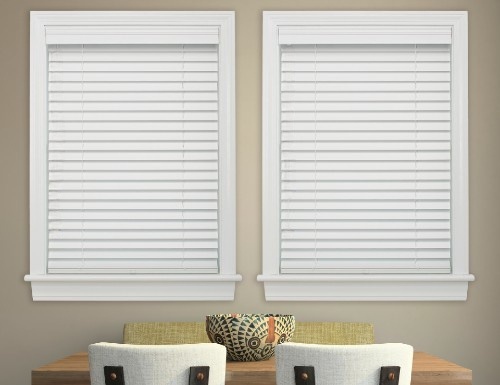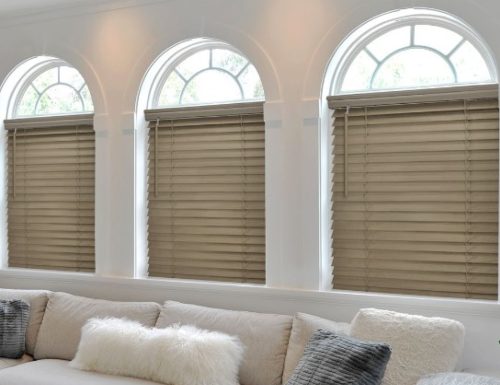Lexi Westingate | Blinds Chalet Design Team
Updated: Sep 17 2024

Real wood blinds add a touch of elegance and functionality to any space. Proper installation is key to ensuring your blinds look great and work smoothly. Whether you’re tackling the installation yourself or hiring a professional, this guide provides essential steps and tips to help you achieve a successful installation.
1. Gather the Necessary Tools
Before starting, make sure you have the right tools on hand. While most real wood blinds come with mounting hardware, you'll need a few additional items to complete the installation.
- Tools Needed:
- Measuring tape
- Power drill (with bits)
- Screwdriver
- Pencil
- Level
- Step ladder
- Mounting brackets and screws (included with blinds)
Pro Tip: Double-check the packaging to ensure all hardware is included, and verify that the blinds’ dimensions match your window measurements before beginning.
2. Measure and Mark Carefully
Accurate measurements are crucial for a proper fit. Even small errors can result in blinds that don’t function correctly or look uneven.
- Inside Mount:
- Measure the width of the window at three points (top, middle, and bottom) and use the smallest measurement. For height, measure from the top of the window to the bottom, using the largest measurement.
- Outside Mount:
- Measure the width of the window and add 2-3 inches on each side for better coverage. For height, measure from the top of the window frame to where you want the blinds to end, typically a few inches below the window.
Pro Tip: For inside mounts, measure inside the window frame and allow space for the mounting
brackets to fit comfortably.
3. Align and Install the Mounting Brackets
Once you’ve marked the spots, it’s time to install the brackets that will hold the headrail.
- Inside Mount Installation:
- 1 Place the brackets inside the window frame and ensure they are level.
- Drill pilot holes for the screws to prevent splitting or damaging the frame.
- Secure the brackets with screws, making sure they are aligned properly.
- Outside Mount Installation:
- 1 Position the brackets above the window frame and ensure they are level.
- Drill pilot holes and secure the brackets with screws. Use a level to confirm that the brackets are perfectly aligned.
4. Install the Headrail
With the brackets in place, you can now install the headrail, which supports the slats.
- Headrail Installation:
- Insert the headrail into the brackets, tilting it if necessary.
- Snap or lock the headrail into place, depending on the bracket type.
- Ensure the headrail is securely fastened and does not move when gently tugged.
Pro Tip: If your blinds include a decorative valance, install it over the headrail after it is
mounted.
5. Attach the Tilt Wand or Cord Mechanism
Attach the tilt mechanism, which controls the slats' movement. Blinds typically come with either
a tilt wand or cord system.
- Tilt Wand Installation: Insert the wand into the mechanism hook on the headrail and ensure it clicks into place.
- Cord Mechanism: If using a cord system, ensure the cords are untangled and operate smoothly when raising, lowering, or tilting the slats.
6. Check and Adjust for Smooth Operation
After installation, test the blinds to ensure they function correctly.
- Raise and Lower the Blinds: Use the cord or lift system to raise and lower the blinds. Ensure the slats move evenly and the blinds stack correctly when raised.
- Tilt the Slats: Adjust the slats using the tilt wand or cord to ensure even opening and closing. If uneven, adjust the bracket alignment as needed.
7. Install the Valance (Optional)
A decorative valance can cover the headrail and enhance the blinds' appearance.
- Valance Installation:
- Attach the clips to the headrail.
- Snap the valance into place over the clips, ensuring it sits flush with the window frame.
8. Safety and Final Adjustments
Consider safety, especially with corded blinds in homes with children or pets.
- Cord Safety: Install cord cleats to keep cords out of reach. Cordless blinds are a safer alternative.
- Final Adjustments: Make any final tweaks to the slats or tilt mechanism. Ensure the blinds are level and the valance is securely attached.
safely out of reach.
Conclusion
Installing real wood blinds is a rewarding project that adds both style and functionality to your home. By following these installation tips—accurate measuring, secure mounting, and functional testing—you’ll ensure your blinds look great and operate smoothly. For those who prefer professional help, Blinds Chalet offers nationwide installation services to ensure a perfect fit. Whether you choose DIY or professional installation, real wood blinds will enhance the elegance of any room.













